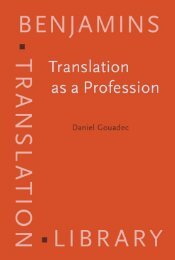Constructing a Sociology of Translation.pdf
Constructing a Sociology of Translation.pdf
Constructing a Sociology of Translation.pdf
- No tags were found...
Create successful ePaper yourself
Turn your PDF publications into a flip-book with our unique Google optimized e-Paper software.
<strong>Translation</strong>s “in the making” 137what he calls a process <strong>of</strong> “traduction” – and a work <strong>of</strong> purification masking theprocess <strong>of</strong> production <strong>of</strong> these hybrids: “L’erreur des modernes sur eux-mêmes estassez facile à comprendre une fois que l’on rétablit la symétrie et que l’on prenden compte à la fois le travail de purification et le travail de traduction. Ils ontconfondu les produits et les procédés” (Latour 1997: 156). In his opinion, in orderto re-establish symmetry and correct the mistake, it is necessary to analyse thesetranslation processes, abandoning Cartesian dichotomies such as body/spirit, human/machineand nature/culture that have long delimited research objects andmethods. Latour replaces the study <strong>of</strong> traditional science with that <strong>of</strong> the world <strong>of</strong>research in order to better grasp where these “hybrids” – scientific facts, theoriesor products <strong>of</strong> technological innovation – originate and what they are made <strong>of</strong>.From this perspective, his two favoured fields <strong>of</strong> study are science laboratoriesand scientific controversies. Starting from these fields and together with fellow researchers(who include Michel Callon, John Law and Andrew Rip), he developedthe actor-network theory.This theory, which thus first attempts to understand innovative processes,draws upon two key concepts: translation and network. In this framework, translationdesignates a process <strong>of</strong> mediation, <strong>of</strong> the interpretation <strong>of</strong> objectives expressedin the “languages” <strong>of</strong> different intermediaries engaged in an innovativeproject/process – intermediaries whose viewpoints and interests are not, initially,necessarily the same. This concept, in sum, refers to the strategies by which objectiveschange and move among the intermediaries, ensuring these persons’ participation,the pursuit <strong>of</strong> the project and the concomitant generation <strong>of</strong> a demandfor the product that will result. 2 For its part, network is defined as a set <strong>of</strong> routesand connections. The concept that lent its name to this theory concerns neither asocial network (since it includes humans and machines alike) nor a technologicalone (since, contrary to such a network, it does not involve a rigid structure). Thesetwo concepts – translation and network – presuppose and underline the creativedimension and, to a certain extent, the unpredictable aspect <strong>of</strong> the processes understudy, as well as the difficulty in reifying them and, thus, the need to studythem from within by turning to, among other things, ethnomethodology.Beyond metaphors: Actor-network theory and translation studiesLatour’s work, like that <strong>of</strong> Pierre Bourdieu, has had applications well beyond theobject with which it was initially concerned, in spheres rather far removed from2. This theory is presented in more detail in Buzelin (2005).
















